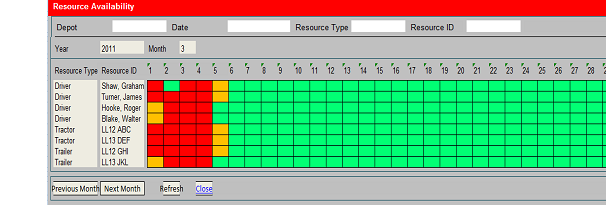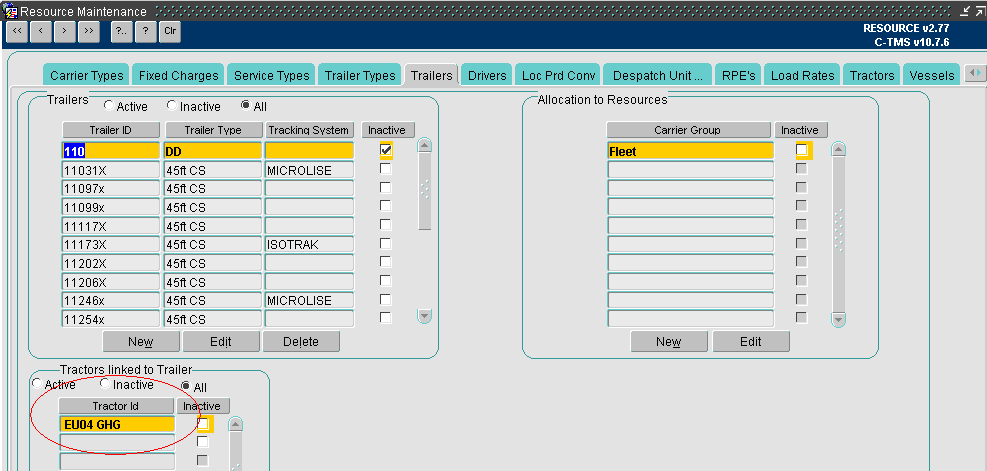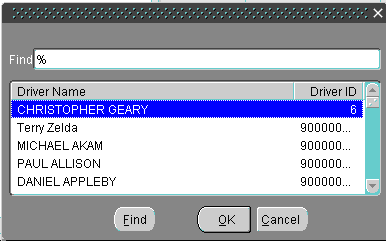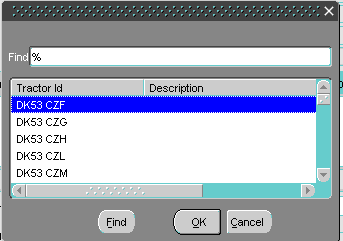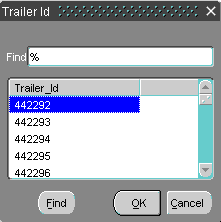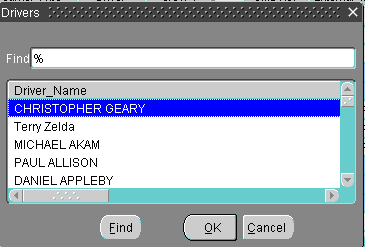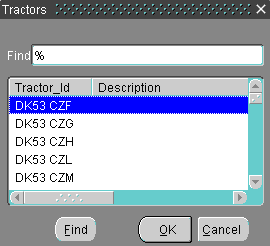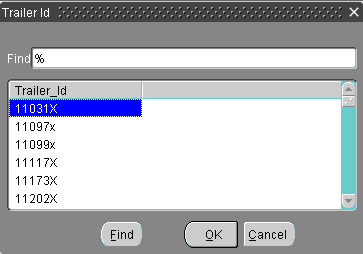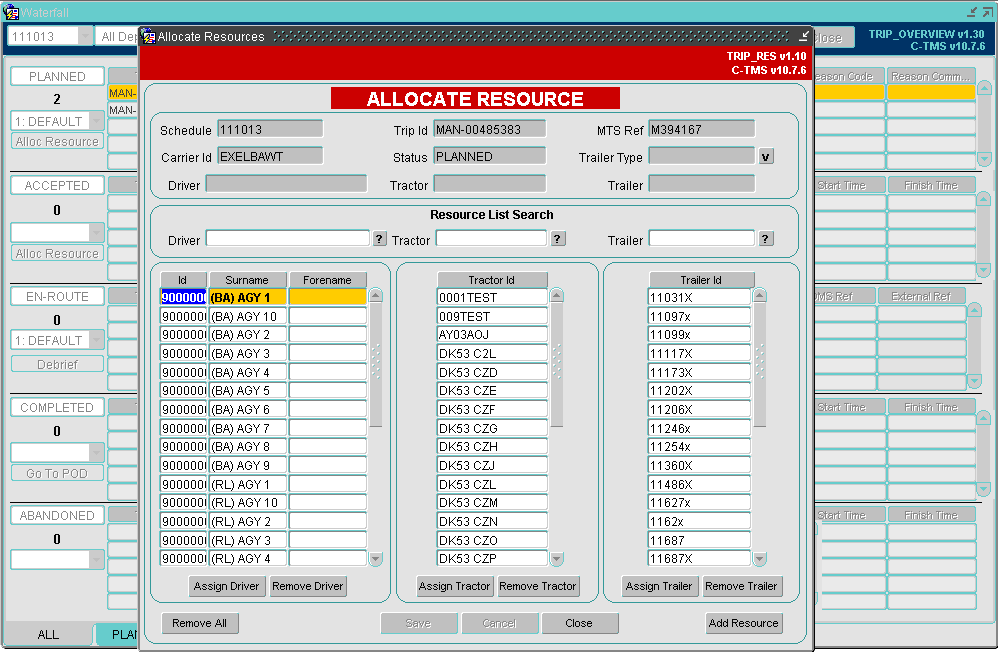292361
![]()
DHL C-TMS
Resource Diary
FUNCTIONAL SPECIFICATION - 10.7
7/11/11 - 1.0
Reference: FS 292361 PM8LZN4D
Client Requirement
Briefing. Resource Diary. Upload of availability, unavailability, VOR, shift plan.
Maintenance in C-TMS.
Resource allocation/briefing to be constrained by resource availability from diary.
Function to remember combination of driver, tractor, and trailer as briefed and offer as default next time.
Solution
Resource Available Table
A new table will be created to store resource availability (Tractor, Trailer and Driver) to every hour within a day.
The table will include the following fields:
Resource Type (‘DRIVER’, ’TRACTOR’ or ‘TRAILER’), Resource ID, Date (not including time), Hour (1 to 24), Available (‘Y’,’N’)
Import
A new C-TMS data import procedure will be developed to allow the resource availability table to be populated from CSV format (managed as spreadsheet files off-line). This will define driver shifts, sickness, trailer maintenance and MOT periods of unavailability.
The fields mentioned in the table above will be included in the import configuration and must all be provided.
If a record for the given resource and hour already exists on file then the ‘Available’ flag will updated on the record to match the new value provided on the import file.
Each record in the import upload file will be validated against the resource information in C-TMS. The drivers and tractors and trailers must already exist in C-TMS resource master tables for the availability data to be successfully uploaded. Any failures will be notified in a results file and a failures CSV format will be created. This ‘failures’ file can be reworked on the user’s desktop and/or reloaded once missing resources are added into C-TMS master tables manually.
Manual Data Maintenance
A new tab will be added to the ‘RESOURCE’ maintenance screen to allow resource availability data to be viewed and changed.
The ‘Resource Availability’ screen will be made up of a header section for the following selection fields:
Depot (can be left blank to show trailers not associated to tractors and so not associated to a specific depot), Date Range (mandatory or a default for today only), Resource Type (‘DRIVER’, ’TRACTOR’, ’TRAILER’ or ‘ALL’), Resource ID (Validated against existing resource tables and as belonging to the specified depot)
The detail of the screen will then show the availability flags by hour of day in a format similar to the requirements design provided by DHL shown below.
Note that Red is unavailable and Green is available.
A Summary display format will be provided that show availability per day rather than per hour.
Note, in summary view the colour highlight will be displayed as Red if the resource is unavailable all day, Green if it is available all day and Orange if it is available for only part of the day.
Depot Validation
Drivers and Tractors will be configured in C-TMS ‘RESOURCE’ master data to belong to a single carrier and that carrier will have a hub location defined for the controlling depot. This means on implementation, a carrier will be created to represent the fleet at each depot.
Trailers can be assigned to a tractor unit in C-TMS ‘RESOURCE’ master data and using this association, the same logic to define depot control described above will be used. If trailers are not assigned to tractors, they will still be available for resource availability view and amend in the screen but accessed using a blank depot code.
Export
A new export for the new resource available table is required (to be covered within scope of RIO PM-8LZMWA Reports).
The output will allow the same selection criteria to control what data is output as the maintenance screen described above.
The output will be a CSV format file containing Depot, Resource Type, Resource Id, Name / Description, Date then 24 flags for the hourly availability (Y or N).
The Export will in principle be the same format as the Import. This means an Export report could be generated and used to form the basis of re-input to C-TMS for a new date range.
The resource data export in CSV format has been de-scoped from RIO PM-8LZMWA.
Resource Allocation (Trips)
The existing resource allocation functionality will be modified to lookup against the resource availability data. The inactive flag that is currently available against each resource will be retained and used as a master override to make a particular resource permanently inactive.
Resource can be entered in Trip Manipulation, Trip Execution and from Trip Overview (Waterfall) and each of these forms will be modified as follows;
The lookup list of resource (Driver, Tractor and Trailer) will show all resource that is available (Y flags) that overlap the planned duration of the trip whether covering the full or just part of the duration. Alongside the resource in the lookup list, C-TMS will also display the time the resource is available from the availability data and this constrained further by any other trip the resource is already allocated to. This time will be displayed with reference to the trip being resourced; for example
If the trip being resource is planned depart at 17/10/11 08:15 and return at 17/10/11 12:00
| Driver | Previous | Available From | Available To | Next |
| Robert Jones | Off Shift | 17/10/11 06:00 | 17/10/11 15:00 | Off Shift |
| Sally Jenkins | Off Shift | 17/10/11 07:00 | 17/10/11 11:30 | PLU-00007910 |
| Mike Smith | Off Shift | 17/10/11 07:00 | 17/10/11 16:00 | Off Shift |
| Keith Davies | PLU‑00007860 | 17/10/11 07:45 | 17/10/11 12:00 | Off Shift |
| Steve James | PLU-00007865 | 17/10/11 08:30 | 17/10/11 12:30 | Off Shift |
N.B. Driver ‘Sally Jenkins’ is greyed out because she is not available for the full duration of the trip because the start of the next trip ‘PLU-00007910’ is before the planned end of the trip being resourced.
N.B. Driver ‘Steve James’ is greyed out because he is not available for the full duration of the trip because the end of the previous trip ‘PLU-00007865’ is after the planned start of the trip being resourced.
The previous and next activity of the driver will be displayed for reference. The previous and next activity could be another trip or Off shift (Inactive). Drivers that are not available for any of the planned duration of the trip either unavailable in resource diary or allocated to another trip will not be displayed at all.
| Tractor | Previous | Available From | Available To | Next |
| DG09 TGH | No Previous | Available | ||
| HJ57 GHD | VOR | 16/10/11 18:00 | Available | |
| KD11 DFW | PLU-00007950 | 17/10/11 06:00 | 17/10/11 18:00 | PLU-00008001 |
| BK10 VFT | PLU-00007865 | 17/10/11 08:00 | Available | |
| FG10 HGR | PLU-00007999 | 17/10/11 08:00 | 18/10/11 08:00 | VOR |
| KJ09 WRD | PLU-00008010 | 17/10/11 09:00 | Available |
Note that blank fields means no constraint for future resource planning in ‘Available To’
If a resource is available for the entire period (of the trip being resource planned), the fields (row) will be white – if not available for the entire period they will be grey – if not available for any of the period they won’t show at all.
Note the date and time of availability (rather than just time) is displayed to better make visible the scenarios. For Drivers the previous and next constraint will be Off Shift or another trip. For Tractor and Trailer previous and next constraint will be VOR or another trip. If ‘No Previous’ record exists (new to fleet for example) and nothing future is planned for the resource so ‘Available’, these values will show in the Previous and Next columns respectively. The available resource lookup lists will be sorted to show the earliest previous availability first.
Note that tractors available for the duration of the trip or part of the duration of the trip will be displayed in the lookup list. The previous and next activity of the tractor will be displayed for reference. The previous and next activity could be another trip, VOR (inactive by diary) or available. The same format will be displayed for trailer lookup.
Note that if no records exist in the resource availability diary, it will be assumed that the resource is available by default (not withstanding being allocated to another trip at the same time of course as described above).
Combinations
C-TMS will be developed to remember the last combination of driver and tractor and trailer used and offer this combination when any one of the three is selected in lookup lists or value keyed directly into driver or tractor or trailer field. Each of the three resources will be independently checked for availability against the diary for the duration of the current trip being resourced and appropriate warnings provided if any conflicts occur.
Scope
This change will be applied to system version 10.7.0.
Set-up
Pre-requisites
None.
Menu Structure
Unchanged.
Data
The new database table ‘RES_AVAILABILITY’ will be created.
The new system parameter ‘RES_AVAILABILITY_ALLOC’ will be created.
The new tab page ‘Resource Availability’ will be available using access control for the user group.
The new import record types will be created for the inbound CSV files.
Implementation Advice
Scripts will be run to create the new database table, system parameter and access control.
Functional Description
Resource Available Table
A new table will be created to store the resource availability data for the tractor, trailer and driver for every hour within a day.
A new database table called ‘RES_AVAILABILITY’ will be created to include the following columns:
| NAME | TYPE | NULLABLE |
| RESOURCE_TYPE | VARCHAR2(12) | N |
| RESOURCE_ID | VARCHAR2(12) | N |
| DATE | DATE | N |
| HOUR | NUMBER(2) | N |
| AVAILABLE | VARCHAR2(1) | N |
A unique primary index will exist for the following columns:
- RESOURCE_TYPE
- RESOURCE_ID
N.B. If the resource type is ‘DRIVER’ then the resource ID will need to be converted to a number for the forename and surname of the driver to be obtained: this is because the driver ID is stored as a numeric and not a character data type.
It is expected that the data will be stored as follows:
| NAME | VALUE |
| RESOURCE_TYPE | ‘DRIVER’, ‘TRACTOR’ or ‘TRAILER’ |
| RESOURCE_ID | ‘RES_PERSON.ID’, ‘RES_TRACTOR.TRACTOR_ID’ or ‘RES_TRAILER.TRAILER_ID’ |
| DATE | YYYYMMDD |
| HOUR | ‘1’ to ‘24’ |
| AVAILABLE | ‘Y’ or ‘N’ |
A record will be created for each hour in the day although the import file will contain all 24 hours for the resource in the same line.
Import
A new C-TMS data import procedure will be developed to allow the resource availability table to be populated from a CSV format (managed as spreadsheet files off-line). This will define driver shifts, sickness, trailer maintenance and MOT periods of unavailability.
The fields mentioned in the table in section 3.1 will be included in the import configuration and must all be provided.
The ‘Import Maintenance’ screen will store the setup for the import files, for example:
| NAME | VALUE |
| FORMAT_NAME | RES_AVAIL |
| IMPORT_TYPE | RES_AVAIL |
| DEFAULT_PATH | C:\temp\ |
| DEFAULT_FILENAME | res_avail.csv |
| TRANSFER_TYPE | ASCII |
| MAX_UPLOADS_PER_PERIOD | 100 |
| DEFAULT_REC_TYPE | RES_AVAIL |
A new import type and a record type of ‘RES_AVAIL’ will be used.
The fields in the files to be uploaded will be delimited using a comma (i.e. ‘,’).
The record type will have the following fields available for selection:
| Field Type | Source Type | Source Value |
| DEPOT | OMIT | 1 |
| RESOURCE_TYPE | FIELD | 2 |
| RESOURCE_ID | FIELD | 3 |
| RESOURCE_DESC | OMIT | 4 |
| DATE | FIELD | 5 |
| HOUR1 | FIELD | 6 |
| HOUR2 | FIELD | 7 |
| HOUR3 | FIELD | 8 |
| HOUR4 | FIELD | 9 |
| HOUR5 | FIELD | 10 |
| HOUR6 | FIELD | 11 |
| HOUR7 | FIELD | 12 |
| HOUR8 | FIELD | 13 |
| HOUR9 | FIELD | 14 |
| HOUR10 | FIELD | 15 |
| HOUR11 | FIELD | 16 |
| HOUR12 | FIELD | 17 |
| HOUR13 | FIELD | 18 |
| HOUR14 | FIELD | 19 |
| HOUR15 | FIELD | 20 |
| HOUR16 | FIELD | 21 |
| HOUR17 | FIELD | 22 |
| HOUR18 | FIELD | 23 |
| HOUR19 | FIELD | 24 |
| HOUR20 | FIELD | 25 |
| HOUR21 | FIELD | 26 |
| HOUR22 | FIELD | 27 |
| HOUR23 | FIELD | 28 |
| HOUR24 | FIELD | 29 |
The depot and the resource description (which will be the driver name, tractor type or trailer type) will be omitted from the import.
For example:
DRIVER,0835,Watson Mike,20111012,N,N,N,N,N,N,N,Y,Y,Y,Y,Y,Y,Y,Y,Y,N,N,N,N,N,N,N,N TRACTOR,EG11 XFG,DAF,20111012,Y,Y,Y,Y,Y,Y,Y,Y,Y,Y,Y,Y,Y,Y,Y,Y,Y,Y,Y,Y,Y,Y,Y,Y
The ‘IMP.IMPORT_SERVER_FILE’ function will be changed to include a call to a new function called ‘F_PROCESS_RES_AVAIL’ for the ‘RES_AVAIL’ import type.
The ‘F_PROCESS_RES_AVAIL’ function will extract the data from the file being uploaded and perform the validation and, if successful, the insertion or update of the data.
Resource Validation
Validation will be performed on the data provided as follows:
- ‘RESOURCE_TYPE’ must be one of ‘DRIVER’, ‘TRACTOR’ or ‘TRAILER’.
- Each ‘RESOURCE_ID’ record in the import upload file will be validated against the resource information in C-TMS. The drivers and tractors and trailers must already exist in the C-TMS resource master tables for the availability data to be successfully uploaded.
For data provided for a resource type of ‘DRIVER’, the resource ID will be validated against the existing driver table (‘RES_PERSON.ID’ with a ‘JOB_TITLE’ of ‘DRIVER’) to ensure that it is a valid driver within C-TMS.
For data provided for a resource type of ‘TRACTOR’, the resource ID will be validated against the existing tractor table (‘RES_TRACTOR.TRACTOR_ID’) to ensure that it is a valid vehicle within C-TMS.
For data provided for a resource type of ‘TRAILER’, the resource ID will be validated against the existing trailer table (‘RES_TRAILER.TRAILER_ID’) to ensure that it is a valid trailer within C-TMS.
- The ‘DATE’ must be valid.
- All 24 ‘HOUR’ periods must be uploaded for the resource.
- If an hour of the day does not have an ‘AVAILABLE’ value of ‘Y’ or ‘N’ provided then it will be processed with a value of ‘Y’ by default.
If a record for the given resource and hour already exists on file then the ‘Available’ flag will updated on the record to match the new value provided on the import file.
Failure Processing
Any failures will be notified in a results file, as per the standard functionality, and a failures CSV format will be created.
This failure file can be reworked on the user’s desktop and/or reloaded once missing resources are added into C-TMS master tables manually.
Manual Data Maintenance
A new tab called ‘Resource Availability’ will be added to the ‘Resource Maintenance’ screen to allow resource availability data to be viewed and changed.
The ‘Resource Availability’ tab page will have a header section for the following selection fields:
- ‘Depot’ (can be left blank to show trailers not associated to tractors and so not associated to a specific depot).
- ‘Date’ (mandatory with a default of the system date).
- ‘Resource Type’ (‘DRIVER’, ’TRACTOR’, ’TRAILER’ or ‘ALL’ (default)).
- ‘Resource ID’ (Validated against existing resource tables and as belonging to the specified depot).
A list of values will exist for the ‘Depot’ field for locations with a type of ‘RDC’ or ‘CROSSDOCK’.
If the ‘Resource Type’ has the default value of ‘All’ then all resources will be displayed in the detail section with the type of resource indicated.
A list of values will exist for the ‘Resource ID’ field if the ‘Resource Type’ has a value of ‘DRIVER’, ’TRACTOR’ or ’TRAILER’. The ‘Depot’ will also be used to provide a valid list of values for the resource type specified.
N.B. The resources may be linked to a specific carrier in the ‘Resource Maintenance’ screen and, if linked, the hub location of the carrier will be used to check that the resource is valid for the ‘Depot’ specified.
The detail section of the tab page will show the availability flags by hour of the day in a format similar to the requirements design provided by DHL shown below:
For example:
N.B. The background colour will be ‘Red’ if the resource is unavailable for that hour time window; or ‘Green’ if it is available.
- Clicking 'Previous Day' will display the resources for the previous calendar day.
- Clicking 'Next Day' will display the resources for the next calendar day.
- Clicking 'Summary' will display the summary section.
- Clicking 'Refresh' will perform a new query for the selection criteria set.
- Clicking ‘Save’ will update any changes made.
- Clicking 'Close' will return the user to the menus.
The ‘RES_AVAILABILITY’ database table will be used to set 24 temporary items in the Oracle Form for the resource for the date displayed.
All of the temporary items in the screen will be displayed initially as available unless there is a database record for the resource for the date displayed: then the temporary items for that resource will be set based on the ‘AVAILABLE’ flag for the corresponding hour of the day.
The selection criteria will be used to select the records from the database table and the first date in the range, if specified, will be used to display the first records.
A vertical scrollbar will be present to display more resources.
N.B. The user will not be able to assign resources to trips in the new tab page but will be able to make a resource available or unavailable by clicking in the box for the hour of the day. If the user clicks in a box that is available then it will become unavailable and vice versa.
A record will be written to the ‘RES_AVAILABILITY’ database table if the user saves a change for the resource for the day, otherwise a record will not exist on the database table because the resource will be available by default.
A summary display format will be provided to show availability per day rather than per hour:
- Clicking 'Previous Month' will display the resources for the previous calendar month.
- Clicking 'Next Month' will display the resources for the next calendar month.
- Clicking 'Refresh' will perform a new query for the selection criteria set.
- Clicking 'Close' will return the user to the detail section.
If the user presses the ‘Summary’ button then the summary section will be displayed and the records will be displayed for the month of the date displayed in the detail section.
The ‘RES_AVAILABILITY’ database table will be used to set 31 temporary items in the Oracle Form for the resource for the date displayed.
All of the temporary items in the screen will be displayed initially as available unless there is a database record for the resource for the date displayed: then the temporary items for that resource will be set based on the ‘AVAILABLE’ flags for the corresponding day of the month.
A vertical scrollbar will be present to display more resources.
N.B. In the summary view, the background colour will be displayed as ‘Red’ if the resource is unavailable all day; ‘Green’ if it is available all day; or ‘Orange’ if it is available for only part of the day.
‘Red’ and ‘Green’ will be existing visual attributes but ‘Orange’ will be the colour scheme ‘Amber’.
Depot Validation
Drivers and Tractors will be configured in the ‘Resource Maintenance’ screen to belong to a single carrier and that carrier will have a hub location defined for the controlling depot. This means, on implementation, a separate carrier ID will be created to represent the fleet at each depot.
Driver/Carrier/Hub:
Tractor/Carrier/Hub:
Trailer/Carrier/Hub:
Trailers can be assigned to a tractor unit in the ‘Resource Maintenance’ screen and using this association, the same logic to define depot control described above will be used. If trailers are not assigned to tractors, they will still be available for viewing and amending in the new ‘Resource Availability’ screen but will need to be accessed without a depot code specified.
Export
A new export called for the new resource available table will be created (to be covered within scope of RIO PM-8LZMWA Reports).
The export file will be the same format as the import file. This means an export report could be generated and used to form the basis of re-input to C-TMS for a new date range.
For example:
DHL,DRIVER,0835,Watson Mike,20111012,N,N,N,N,N,N,N,Y,Y,Y,Y,Y,Y,Y,Y,Y,N,N,N,N,N,N,N,N DHL,TRACTOR,EG11 XFG,DAF,20111012,Y,Y,Y,Y,Y,Y,Y,Y,Y,Y,Y,Y,Y,Y,Y,Y,Y,Y,Y,Y,Y,Y,Y,Y
This CSV data export has been de-scoped as a deliverable from RIO PM-8LZMWA.
Resource Allocation (Trips)
The existing resource allocation functionality will be modified to check the resource availability data if a new cost-centre level system parameter called ‘RES_AVAILABILITY_ALLOC’ is set to ‘Y’.
The inactive flag that is currently available against each resource will be retained and used as a master override to make a particular resource permanently inactive.
For example:
Trip Manipulation:
Trip Execution:
Trip Overview (Waterfall):
Resources can be entered in the ‘Trip Manipulation’, ‘Trip Execution’ and ‘Trip Overview (Waterfall)’ screens and each of these forms will be modified as follows:
- The lookup list of resource (‘Driver’, ‘Tractor’ and ‘Trailer’) will show all resources that are available (‘Green’) that overlap the planned duration of the trip, whether covering the full duration or just part of the duration.
- Alongside the resource in the lookup list, C-TMS will also display the time that the resource is available from the resource availability data and this will be constrained further by any other trip the resource is already allocated to.
- This time will be displayed with reference to the trip being resourced.
The duration of the trip will be considered as between the planned departure time at the first trip stop and the planned arrival time at the last trip stop.
The ‘Allocate Resources’ screen in the ‘TRIP_RES’ from will be changed for the allocation of resources in the ‘Trip Overview (Waterfall)’ screen.
N.B. The ‘Allocate Resources’ screen for the crew in the ‘TRIP_RES_CRW’ form will not be changed because this version will not be used by ‘Gamma’.
The width of the window and canvas will be increased to enable the extra columns to be displayed for each type of resource as an overlay window and canvas:
- Previous
- Available From
- Available To
- Next
The start of the trip will be considered to be the planned arrival time of the first stop and the end of the trip to be the planned departure time of the last stop. These times will be stored against the trip as the start and end times (i.e. ‘SCH_TRIP.START_TIME’ and ‘SCH_TRIP.END_TIME’).
If the resource is available during the same minute as the trip times then it will be considered as available because the time window will be inclusive. For example, if the trip being resourced starts at 08:15 and the driver is assigned to a trip that ends at 08:15 then that driver will be available for assigning to the trip being resourced, however, if the trip were to end at 08:16 then that driver would be unavailable because the driver would not be available before that start of the time window.
For a trip being resourced starts at 17/10/11 08:15 and ends at 17/10/11 12:00:
Driver:
| Driver | Previous | Available From | Available To | Next |
| Robert Jones | Off Shift | 17/10/11 06:00 | 17/10/11 15:00 | Off Shift |
| Sally Jenkins | Off Shift | 17/10/11 07:00 | 17/10/11 11:30 | PLU-00007910 |
| Mike Smith | Off Shift | 17/10/11 07:00 | 17/10/11 16:00 | Off Shift |
| Keith Davies | PLU‑00007860 | 17/10/11 07:45 | 17/10/11 12:00 | Off Shift |
| Steve James | PLU-00007865 | 17/10/11 08:30 | 17/10/11 12:30 | Off Shift |
| John Williams | Off Shift | 17/10/11 08:00 | 17/10/11 09:00 | PLU-00007870 |
| John Williams | PLU‑00007870 | 17/10/11 11:30 | 17/10/11 16:00 | Off Shift |
Driver ‘Sally Jenkins’ is greyed out because she is not available for the full duration of the trip because the start of the next trip ‘PLU-00007910’ is before the planned end of the trip being resourced.
Driver ‘Steve James’ is greyed out because he is not available for the full duration of the trip because the end of the previous trip ‘PLU-00007865’ is after the planned start of the trip being resourced.
The previous and next activity of the driver will be displayed for reference. The previous and next activity could be another trip or ‘Off Shift’ (i.e. inactive). Drivers who are not available for any of the planned duration of the trip because they are either unavailable in the resource diary or they are allocated to another trip for the duration of the trip being resourced will not be displayed at all.
N.B. Multiple records can be displayed for the same resource if the resource is available more than once within the time window of the trip being resourced. For example, a driver is assigned to a trip between 09:00 and 11:30 and is therefore available for resourcing between 08:15 and 09:00 and between 11:30 and 12:00. See driver John Williams in the above table.
Tractor/Trailer:
| Tractor | Previous | Available From | Available To | Next |
| DG09 TGH | No Previous | Available | ||
| HJ57 GHD | VOR | 16/10/11 18:00 | Available | |
| KD11 DFW | PLU-00007950 | 17/10/11 06:00 | 17/10/11 18:00 | PLU-00008001 |
| BK10 VFT | PLU-00007865 | 17/10/11 08:00 | Available | |
| FG10 HGR | PLU-00007999 | 17/10/11 08:00 | 18/10/11 08:00 | VOR |
| KJ09 WRD | PLU-00008010 | 17/10/11 09:00 | Available |
N.B. A blank field means that there is no constraint for future resource planning in the ‘Available From’ or ‘Available To’ time. It is expected that the drivers will be included in the ‘Resource Diary’ so there should always be a previous or next shift to reference.
If a tractor or a trailer is not ‘off road’ in the ‘Resource Diary’ and it has not been allocated to a trip then the available times can be blank because a constraint does not exist.
If a resource is available for the entire period (of the trip being resourced), the fields (row) will be white – if not available for the entire period they will be grey – if not available for any of the period they won’t show at all.
The record will appear as grey because the ‘ALLOCATED’ visual attribute is set and white because the ‘DEFAULT’ visual attribute is set.
N.B. The date and time of availability (rather than just the time) will be displayed to improve visibility should the duration of the trip be over more than one calendar day.
For drivers the previous and next constraint will be ‘Off Shift’ or another trip.
For tractors and trailers, the previous and next constraint will be ‘VOR’ (i.e. ‘Vehicle Off Road’) or another trip. If ‘No Previous’ record exists (e.g. it is new to the fleet) and nothing in the future is planned for the resource then ‘Available’ will be displayed, these values will show in the ‘Previous’ and ‘Next’ columns respectively.
N.B. Tractors available for the duration of the trip, or part of the duration of the trip, will be displayed in the lookup list. The previous and next activity of the tractor will be displayed for reference. The previous and next activity could be another trip, ‘VOR’ (i.e. inactive in the ‘Resource Diary’) or ‘Available’. The same logic will be displayed for the trailer lookup.
The available resource lookup lists will be sorted to show the earliest previous availability first (i.e. by the dates and times shown in the ‘Available From’ column in ascending order).
N.B. If no records exist in the resource availability diary, it will be assumed that the resource is available by default (not withstanding being allocated to another trip at the same time of course as described above).
Suggested Resource Combinations
The trip planning screens will be changed to assess the last combination of driver and tractor and trailer used and offer this combination when any one of the three resources is selected in a list of values, or a value is keyed directly into the driver, tractor or trailer fields.
The last combination will be obtained from the trip with the same resource and cost centre; not on a future schedule; and with the latest start time.
If the system parameter ‘RES_AVAILABILITY_ALLOC’ is ‘Y’ for the cost centre of the trip, a popup box will be displayed to allow the user to accept or reject the suggested combination for the other resources. These other resources will only be replaced should they not have been set and the user accepts the suggested combination.
Each of the three resources will be independently checked for availability against the diary for the duration of the current trip being resourced and appropriate warnings provided if any conflicts occur. A ‘greyed-out’ resource may be selected, or an unavailable resource keyed, although the resource is not expected to be used for the current planning stage.
Table Updates Required
A new database table called ‘RES_AVAILABILITY’ will be created as described in section 3.1.
Modules to be changed
| Module Name | Module Type | Notes |
| RESOURCE.fmb | Form | New tab page |
| TRIPSUM.fmb | Form | New resource selection |
| TRIP_OVERVIEW.fmb | Form | New resource selection |
| TRIP_PLAN.fmb | Form | New resource selection |
| TRIP_RES.fmb | Form | New resource data |
| IMP.sql | Package | New import type |
References
| EST-292361 PM-8LZN4D Resource Diary v2.0.doc | |||
Glossary
| C-TMS | Calidus TMS |
Document History
| Initial version | ||||
| Review and Issue | ||||
AUTHORISED BY
| Matt Crisford | Development Manager | |
| Peter Greer | TMSCC MTS Product Manager |



